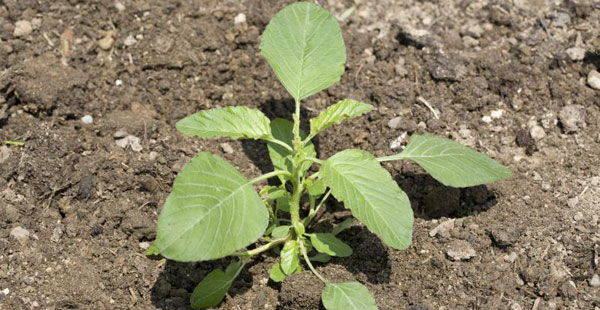Six Questions to Ask Yourself When Developing Your Weed Control Program
March 28, 2020

Weeds can have a staggering effect on corn yields. In addition to stunting growth and stealing away water and nutrients, driver weeds such as Palmer amaranth and waterhemp have developed resistance to some herbicides. Geography and weather can further promote weed development, providing an increase in the natural elements that weeds need to enhance their own germination.
Controlling the seed bank is the cornerstone of any weed-management program
“Controlling the seed bank is a numbers game,” says Mark Waddington, selective corn herbicides product development manager at Bayer. “The fewer weed seeds, the less chance of emergence and competition, and the lower the risk of resistance development. A long-term weed management program manages the things that affect yield and, at the end of the day, production. It all comes down to how much competition exists in a field.”
As the challenge of resistant weeds continues, many growers have begun to take a closer look at their weed control approach.
“Growers have always known weed control is critical. However, they are now realizing that some of their practices need to evolve to stay ahead of the weed threat,” adds Frank Rittemann, selective corn herbicides product manager for Bayer.
Rittemann says that during and after harvest is the perfect time to evaluate a weed-management program since growers have spent many hours in the field and can evaluate if there are any weed escapes. He and Waddington recommend that during harvest and planning, growers ask themselves six questions to determine the best weed-control program for their operation.
- What is the history of the field? Understand the current and past weed pressure in a field, including the specific weed species and resistance issues. It’s also important to understand the herbicide history of the field. In fact, a study from the University of Illinois found that management of a field was the most important factor when it came to resistance issues in a field.
- What is the weed pressure in the region? Consider not just weed pressure in the surrounding fields, but also throughout the local geography. The prevalence of resistant weeds grows every year, so agronomists and extension agents are great resources to learn more about the prevalence of specific species in a region.
- What type of weather does the field typically experience? Mother Nature plays a significant part in any herbicide program and its effectiveness. Waddington says that environmental factors, such as rain and temperature affect how herbicides work.
- How does the soil hold the herbicide? “The more productive soils, generally, have higher organic matter,” says Waddington. “They will hold herbicides better.” This means that heavier, heartier soils can absorb and hold on to a herbicide for longer periods of time, whereas in sandy and lighter soils herbicides are at risk of being flushed away with rain.
In addition to herbicide absorption capabilities in the soil, type and organic matter content are to other important factors to consider in selecting herbicide use rates. - What is the right level of investment for weed control on my operation? Some growers may be yield maximizers, looking to get the most out of every acre. Other growers focus on optimizing weed management costs per acre. In planning a weed-control program, growers should consider yield goals, the type of crop that will be grown and the current market conditions, among other crop-management decisions.
- How do weed escapes affect my season-long plan through harvest? Weed escapes compete with nutrients. If left in fields, they can chip away at crop potential.
Once growers have answered these six questions, Rittemann and Waddington recommend they determine if a one-pass or two-pass approach works best for them and then find products that work with their selected approach. Recommended products include:
At Planting:
- Corvus® herbicide, tankmixed with Harness® Xtra herbicide, provides four distinct sites of action to help control weeds at pre-emergence. With as little as a half-inch of rain, Corvus reactivates to help wipe out tough, resistant weeds. Harness Xtra provides broad spectrum control of more than 40 grasses and broadleaf weeds.
Post Emergence:
- DiFlexx® DUO herbicide, tankmixed with a Roundup® brand agricultural herbicide, is tough on problem weeds, including glyphosate-resistant Palmer amaranth, waterhemp, ragweed and marestail. It also has built-in resistance management with two effective sites of action.
Best Management Practices for Weed Control
- Maintain cultural practices of even row spacing and working field grounds
- Scout early and stay ahead of weed emergence
- Be aware of application timing and spray as early as possible
ALWAYS READ AND FOLLOW PESTICIDE LABEL DIRECTIONS. Corvus® and Harness® Xtra are restricted use pesticides. Not all products are registered in all states and may be subject to use restrictions. The distribution, sale, or use of an unregistered pesticide is a violation of federal and/or state law and is strictly prohibited. Check with your local dealer or representative for the product registration status in your state. Bayer, the Bayer Cross, Corvus, DiFlexx, Harness and Roundup PowerMAX are registered trademarks of Bayer Group. For additional product information call toll-free 1-866-99-BAYER (1-866-992-2937) or visit our website at www.BayerCropScience.us. Bayer CropScience LP, 800 North Lindbergh Boulevard, St. Louis, MO 63167. ©2020 Bayer Group. All rights reserved.